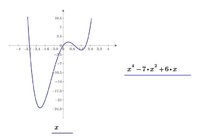HelpMehhhhh
New member
- Joined
- Oct 22, 2020
- Messages
- 24
Write a polynomial inequality with a quartic function that is > 0 (greater than zero) on the interval
(−5, −5/2) ∪ (1 − √2, 1 + √2). Express the factors with rational coefficients. You do not need to expand.
Above question is confusing and can't seem to understand it
(−5, −5/2) ∪ (1 − √2, 1 + √2). Express the factors with rational coefficients. You do not need to expand.
Above question is confusing and can't seem to understand it

